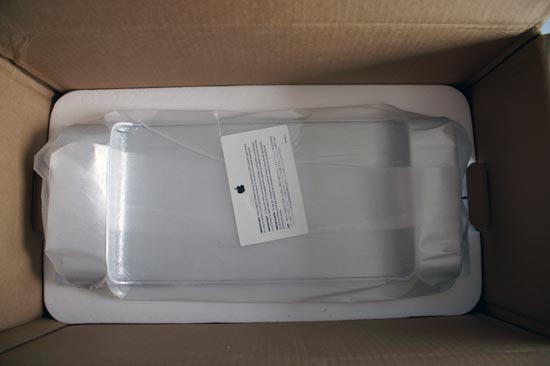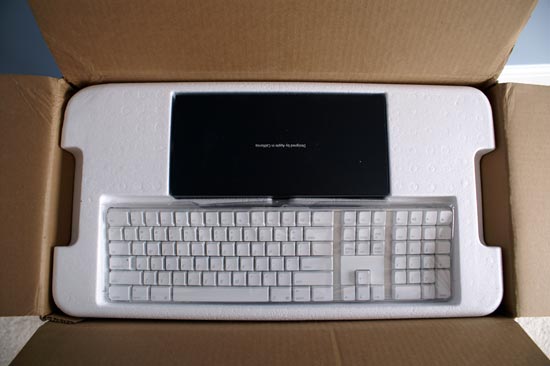Apple's Mac Pro - A True PowerMac Successor
by Anand Lal Shimpi on August 16, 2006 12:27 PM EST- Posted in
- Mac
It's here, it's quiet and it's fast; we got our Mac Pro on Friday and spent every day since taking it apart, using it and benchmarking it. There's far too much to include in one review, so we're breaking it up into three parts. We've already published the first part of our coverage last week, where we discussed the specifications of the new system as well as inadvertently turned the article into a primer on the implications of the FB-DIMMs that the Mac Pro uses. So if you want a brief two-page technical overview of FB-DIMMs, you'll want to consult that article.
Part two is what you're reading today; here we're going to be looking at the Mac Pro as a Mac (mostly) and compare the performance of two speed grades (2.0GHz and 2.66GHz) to the outgoing PowerMac G5. We'll also take the thing apart and give you a nice tour in pictures of the new chassis.

PowerMac G5 (left), Mac Pro box (guess where)
The third and final part will have two focuses - DIY upgrades (e.g. swapping CPUs and sticking in your own FB-DIMMs) as well as performance under Windows XP. Apple just released an updated version of Boot Camp with support for the Mac Pro that should hopefully address some of the serious performance issues we ran into while running Windows XP on our machine. Give us a week and you'll have part 3 to peruse at your leisure.
With our plan of attack laid out, it's time to dive into the Mac Pro and we'll start where very few Mac users like to: at its price. In the past we've generally shied away from getting too caught up in the price debate, because honestly if you're buying a Mac, you're doing so because of the OS and assigning value to that is difficult. Some users are content with other OSes and see no value in OS X, and to them the value in a Mac is simply the total cost of the components that make up the machine. At the same time there are other users who prefer OS X and thus find additional value in a system that is able to run that OS. Regardless of which camp you fall into, the Mac Pro is competitively priced. We'll let the table below do the talking:
|
Apple Mac Pro |
Dell Precision Workstation 490 |
Home Built Config |
|
|
CPU |
2 x Xeon 5150 (2.66GHz) |
2 x Xeon 5150 (2.66GHz) |
|
|
Memory |
2x 512MB DDR2-667 FB-DIMMs |
2x 512MB DDR2-667 FB-DIMMs |
|
|
Graphics |
GeForce 7300 GT |
Quadro NVS 285 |
|
|
Hard Drive |
250GB SATA 3Gbps |
250GB SATA 3Gbps |
|
|
Optical |
SuperDrive (DVD+R DL/DVD+-RW/CD-RW) |
16X DVD+-RW |
|
|
Notes |
Free 17" LCD, had to add sound card, mouse and 1394a card |
Includes Supermicro X7DAE motherboard priced at $474; does not include price of OS, case or power supply |
|
|
Price |
$2499 ($2299 with educational discount) |
$3110 |
$2390 |
The Dell is clearly more expensive, although you can knock off $100 - $200 thanks to the bundled LCD (unfortunately Dell gives you $0 credit if you remove the monitor from your order). We're able to come close with our own configuration by shopping at Newegg and other vendors through our shopping partner, but note that the $2390 total does not include an OS, case or power supply.

If you're in the market for a dual socket dual core Xeon workstation, Apple's Mac Pro is definitely a bargain. The only real issue here is that not everyone needs or can adequately use a dual socket Xeon workstation, in which case you can argue that there's better value in a cheaper single socket Core 2 system. Unfortunately Apple does not offer any such system, which leads us to believe that we'll either eventually see the introduction of a cheaper single socket Mac Pro or maybe even a new product line simply called the "Mac" that uses desktop Core 2 processors instead of their Xeon counterparts.
Bottom line? The default configuration of the Mac Pro is priced very competitively for what you get; whether or not you need what you get is a different discussion entirely.












96 Comments
View All Comments
michael2k - Wednesday, August 16, 2006 - link
1:) Well, according to Anandtech's calculations, it's cheaper to buy a quad CPU Mac than to build one.2:) iLife is better than "free crap"
3:) Macs can run Windows, BSD, Linux, and OS X all at once; PCs cannot
4:) Drive sleds
5:) Ram risers
6:) Quiet case
7:) 6 SATA connectors
8:) 4 PCIe slots and 8 monitors
retrospooty - Thursday, August 17, 2006 - link
Yes, in general, good quality components cost more than cheap crap... This is why Acura and Lexus cost more than a Ford, even though they are all built in hte USA. Would you rather get the mobo, memory, HDD, and video card that some kind and caring (cough cough) company landed a mulimillion dollar cotract to buy 10's of thousands, or pick your own?What is your point?
nexcom - Saturday, November 28, 2009 - link
yes good and quality also mater aswell ok.michael2k - Thursday, August 17, 2006 - link
My point was that you got better build quality than the average DIY case:You get HDD sleds, cablefree installation, 2 gigE ports, 6 SATA connectors, etc, etc, etc.
Not everyone has the skill, time, or resources to do their own research, shopping around, and haggling, you know.
Are you arguing against, similarly, mass produced cars, TVs, homes, fridges, and furniture over DIY solutions?
Or do you shop at Target and Walmart too?
retrospooty - Thursday, August 17, 2006 - link
MAybe I am dense, but I am still missing your point... Anyhow, Apple's MAC's, or Dell, or any other vendor for that matter are not of high quality parts. The CPU's are great, most of the rest is cheap deal based components. Yes, most people lack the knowledge to build thier own systems, and they buy Dell's, and MAC's and such. All I am saying is that those systems arent at all using all the best high quality/high performance parts.michael2k - Thursday, August 17, 2006 - link
So I'm asking if you are consistent.Do you refuse to buy at Walmart and Target because they sell mass produced furniture, clothing, and household goods because they don't happen to use the highest quality materials? Do you, instead, build your own furniture, make your own clothes, grow your own produce, and make your own electronics?
I don't see your point, because you haven't proven it, that Macs use "cheap deal based components". The case is definitely not "cheap deal based components" because it is crafted of aluminum ONLY for Apple, and it is quite nonstandard compared to the average PC case. Then there is the Mac motherboard, which as far as I can tell is also unique, being a Xeon EFI based motherboard, crafted singularly for Apple, most likely by Intel itself. The video card, yes, it is cheap, but that saves the user money too, and is no worse than an off the shelf NVIDIA video card.
Where is your proof that the Mac Pro has cheap, unreliable, components?
retrospooty - Friday, August 18, 2006 - link
you're wearing me out... I give. Long live the MAC, may Apple break thier 10 year rut and finally get more than 3% global marketshare, maybe even 5%. Whoopdeedoo. Yippee skip.BTW, Apple's beautiful aluminum cases are a total ripoff (if not an out right purchase)of the Lian Li design. EFI is an average/cheap mobo maker at best (not to say unreliable, just average in function, and performance). They are no DFI, or ASUS, not even close.
Maury Markowitz - Friday, August 18, 2006 - link
You really are trolling...> total ripoff of the Lian Li
Well I've actually used one of these, which I really doubt you can claim, and they're certainly nothing at all like the Apple case. Or are you overheating those two brain cells because both cases happen to use aluminum? I guess, by that brilliant logic, that Apple stole the design of their cases from the Dornier Dr.I from World War I. After all, that used aluminum too.
For the record, the Lian Li design doesn't show a single one of the features that the Apple industrial design team put into the Mac Pro. They are, quite simply, bog-standard PC cases made of aluminum instead of stamped steel. That's it. For instance, the drives slide in from the front through a removable panel, are fastened into place with tiny little screws, and connected to the mobo with cables. Does this sound like the Mac Pro in any way whatsoever? Well pictures are worth a thousand words:
http://silverpcs.com/product_info.php?products_id=...">http://silverpcs.com/product_info.php?products_id=...
> EFI is an average/cheap mobo maker
Stop! Please, stop! My ribs are aching!
Hey brainiac, EFI is not a company.
> They are no DFI, or ASUS, not even close.
I hope not, considering it's an acronym for a boot standard.
If this is the basis of your "Apple is cheap" argument, you really are a moron.
Maury
retrospooty - Friday, August 18, 2006 - link
Sorry to all, my bad, I read too quickly and I thought the post above was stating that EFI (the company) made Apple's new mobo's.Anyhow, I was not saying they are particularily bad, or cheap, I was saying ALL manufacturers use "average" parts in thier systems, including Apple. Aplle may well be at or very near the best of the list of major manufactureres, but its still not like hand picking your own motherboard, ram, v card, HDD etc. In other words, if Apple was an open standard, and any manufacturer could make parts for it, you would see alot of higher quality parts from some of those vendors.
Any Yes, the case appearance is a TOTAL ripoff of Lian Li. The interior is certianly not, bute the look and feel externally, is identical, right down to the holes.
Anyhow, I am done on this one, I have riled up enough MAC fanboy anger for now :D LONG LICE MAC, may their marketshare double to a whopping 6% !
michael2k - Friday, August 18, 2006 - link
Right, a total ripoff... you sound like a broken record. Look at Anand's review here:http://www.anandtech.com/showdoc.aspx?i=2040&p...">http://www.anandtech.com/showdoc.aspx?i=2040&p...
It was introduced in April of 2004... almost a full year after Apple introduced their PowerMac G5 in June of 2003. The case design, with the cooling zones, grill face, and inverted motherboard all debuted in an Apple design and then was copied by Lian Li. This has nothing to do with being a fanboy and everything to do with being right.
You believe Apple ripped off the Lian Li... fine, link the Lian Li that preceeded the PowerMac G5 case!